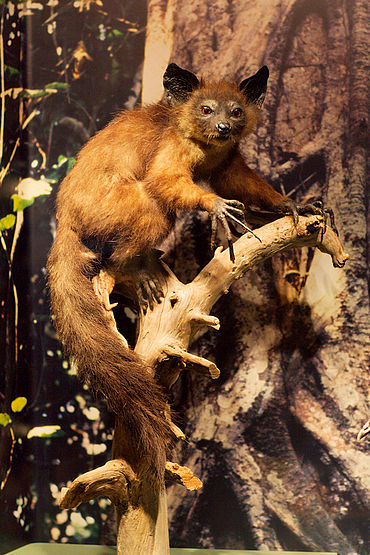Template:Species-2013-05
Species of the month[edit]
Aye-aye[edit]
Some facts on this mammal:
Size: Head and body about 40 cm.; tail about 60 cm.
Weight: 2 kg.
Distribution: Found only on the island of Madagascar.
Diet: Omnivore: eats animal matter, nuts, insect larvae, fruit, nectar, seeds, and fungi.
Average life span: 20 years in captivity.
Protection status: Near Threatened (IUCN 3.1).
First described: By the German naturalist, botanist and entomologist Johann Friedrich Gmelin in 1788.
Daubentonia madagascariensis may look to you like a rodent, but it actually is a primate, related to monkeys, apes, and humans. Equipped with a bushy tail that is larger than the body, big eyes, slender fingers, and large, sensitive ears, the aye-aye is an impressive animal. It has pointed claws on all the fingers and toes except for the opposable big toes, which enable it to dangle from branches. Daubentonia madagascariensis is a nocturnal species which dwells in rain forest trees and avoids coming down to earth. During the day it curls up in a ball-like nest of leaves and branches. While perched aloft, the aye-aye uses its extra-long middle finger to tap on trees listening for wood-boring insects' larvae crawling underneath the bark. With the same middle finger it then fishes them out. This digit is also useful for scooping the flesh out of fruits such as coconuts. Many Madagascan natives consider the aye-ayes an omen of ill luck which must be killed when sighted. Being now critically endangered animals, they are protected by law.
See also: Species of previous months
